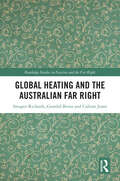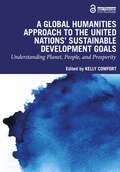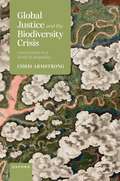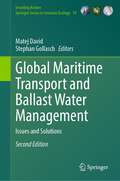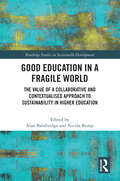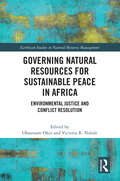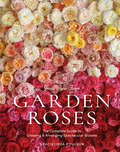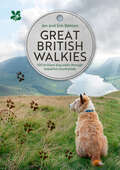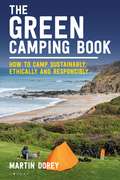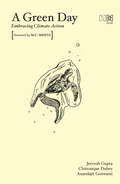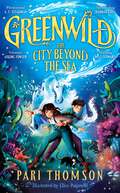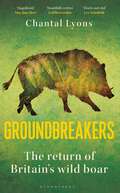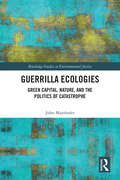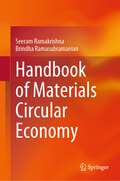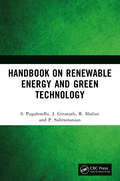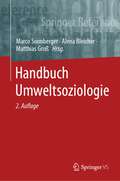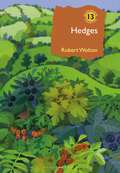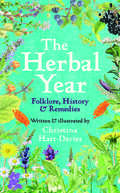- Table View
- List View
Global Heating and the Australian Far Right (Routledge Studies in Fascism and the Far Right)
by Imogen Richards Gearóid Brinn Callum JonesGlobal Heating and the Australian Far Right examines the environmental politics of far-right actors and movements in Australia, exploring their broader political context and responses to climate change.The book traces the development of far-right pseudo-environmentalism and territorial politics, from colonial genocide and Australian nationalism to extreme-right political violence. Through a critical analysis of news and social media, it reveals how denialist and resignatory attitudes towards climate change operate alongside extreme right accelerationism, in a wider Australian political context characterised by reactionary fossil fuel politics and neoliberal New Right climate change agendas. The authors scrutinise the manipulation of environmental politics by contemporary Australian far- and extreme-right actors in cross-national online media. They also assess the political-ideological context of the contemporary far right, addressing intergovernmental approaches to security threats connected to the far right and climate change, and the emergence of radical environmentalist traditions in ‘New Catastrophism’ literature. The conclusion synthesises key insights, analysing the mainstreaming of ethnonationalist and authoritarian responses to global heating, and potential future trajectories of far-right movements exploiting the climate crisis. It also emphasises the necessity for radical political alternatives to counter the far right’s exploitation of climate change.This book will be of interest to researchers of climate change, the far right, neoliberal capitalism, extremism and Australian politics.
Global Heating and the Australian Far Right (Routledge Studies in Fascism and the Far Right)
by Imogen Richards Gearóid Brinn Callum JonesGlobal Heating and the Australian Far Right examines the environmental politics of far-right actors and movements in Australia, exploring their broader political context and responses to climate change.The book traces the development of far-right pseudo-environmentalism and territorial politics, from colonial genocide and Australian nationalism to extreme-right political violence. Through a critical analysis of news and social media, it reveals how denialist and resignatory attitudes towards climate change operate alongside extreme right accelerationism, in a wider Australian political context characterised by reactionary fossil fuel politics and neoliberal New Right climate change agendas. The authors scrutinise the manipulation of environmental politics by contemporary Australian far- and extreme-right actors in cross-national online media. They also assess the political-ideological context of the contemporary far right, addressing intergovernmental approaches to security threats connected to the far right and climate change, and the emergence of radical environmentalist traditions in ‘New Catastrophism’ literature. The conclusion synthesises key insights, analysing the mainstreaming of ethnonationalist and authoritarian responses to global heating, and potential future trajectories of far-right movements exploiting the climate crisis. It also emphasises the necessity for radical political alternatives to counter the far right’s exploitation of climate change.This book will be of interest to researchers of climate change, the far right, neoliberal capitalism, extremism and Australian politics.
A Global Humanities Approach to the United Nations' Sustainable Development Goals: Understanding Planet, People, and Prosperity
This edited textbook explores the 17 UN SDGs through 12 works from the humanities, including films, novels, and photographic collections. It provides students with the knowledge and understanding of how the humanities engage in broader social, political, economic, and environmental dialogue, offering a global perspective that crosses national and continental borders. The book takes students through the UN SDGs from a theoretical perspective through to practical applications, first through specific global humanities examples and then through students’ own final projects and reflections. Centered around three major themes of planet, people, and prosperity, the textbook encourages students to explore and apply the Goals using a place-based, culturally rooted approach while simultaneously acknowledging and understanding their global importance. The text’s examples range from documentary and feature film to photography and literature, including Wang Jiuliang’s Plastic China, Kip Andersen and Keegan Kuhn’s Cowspiracy: The Sustainability Secret, Barbara Dombrowski’s Tropic Ice: Dialog Between Places Affected by Climate Change, and Aravind Adiga’s The White Tiger, among others. Providing diverse geographic and cultural perspectives, the works take readers to Argentina, Australia, China, Costa Rica, Ecuador, France, Greenland, Haiti, India, Japan, Peru, Rwanda, Senegal, and the United States. This broad textbook can be used by students and instructors at undergraduate and postgraduate levels from any subject background, particularly, but not exclusively, those in the humanities. With added discussion questions, research assignments, writing prompts, and creative project ideas, students will gain a nuanced understanding of the interconnectivity between social, cultural, ethical, political, economic, and environmental factors.
A Global Humanities Approach to the United Nations' Sustainable Development Goals: Understanding Planet, People, and Prosperity
by Kelly ComfortThis edited textbook explores the 17 UN SDGs through 12 works from the humanities, including films, novels, and photographic collections. It provides students with the knowledge and understanding of how the humanities engage in broader social, political, economic, and environmental dialogue, offering a global perspective that crosses national and continental borders. The book takes students through the UN SDGs from a theoretical perspective through to practical applications, first through specific global humanities examples and then through students’ own final projects and reflections. Centered around three major themes of planet, people, and prosperity, the textbook encourages students to explore and apply the Goals using a place-based, culturally rooted approach while simultaneously acknowledging and understanding their global importance. The text’s examples range from documentary and feature film to photography and literature, including Wang Jiuliang’s Plastic China, Kip Andersen and Keegan Kuhn’s Cowspiracy: The Sustainability Secret, Barbara Dombrowski’s Tropic Ice: Dialog Between Places Affected by Climate Change, and Aravind Adiga’s The White Tiger, among others. Providing diverse geographic and cultural perspectives, the works take readers to Argentina, Australia, China, Costa Rica, Ecuador, France, Greenland, Haiti, India, Japan, Peru, Rwanda, Senegal, and the United States. This broad textbook can be used by students and instructors at undergraduate and postgraduate levels from any subject background, particularly, but not exclusively, those in the humanities. With added discussion questions, research assignments, writing prompts, and creative project ideas, students will gain a nuanced understanding of the interconnectivity between social, cultural, ethical, political, economic, and environmental factors.
Global Justice and the Biodiversity Crisis: Conservation in a World of Inequality
by Chris ArmstrongThe world is in the midst of a biodiversity crisis, which existing conservation policies have failed to arrest. Policymakers, academics, and the general public are coming to recognise that much more ambitious conservation policies are in order. But biodiversity conservation raises major issues of global justice - even if the connection between conservation and global justice is too seldom made. The lion's share of conservation funding is spent in the global North, despite the fact that most biodiversity exists in the global South, and local people can often scarcely afford to make sacrifices in the interests of biodiversity conservation. Many responses to the biodiversity crisis threaten to exacerbate existing global injustices, to lock people into poverty, and to exploit the world's poor. At the extreme, policies aimed at protecting biodiversity have also been associated with exclusion, dispossession, and violence. The challenge this book grapples with is how biodiversity might be conserved without producing global injustice. It distinguishes policies which are likely to exacerbate global injustice, and policies which promise to reduce them. The struggle to formulate and implement just conservation policies is vital to our planet's future.
Global Maritime Transport and Ballast Water Management: Issues and Solutions (Invading Nature - Springer Series in Invasion Ecology #16)
by Matej David Stephan GollaschIn 2015 the first edition of this book was published before the Ballast Water Management (BWM) Convention entered into force. To our knowledge this was and still is the first comprehensive book on BWM worldwide. It provided an overview of possible solutions to the complex issue of BWM. It further outlined consequences and implications to address the ballast water "problem" in line with provisions of the BWM Convention considering environmental, shipping, legal and policy perspectives. The previously addressed subjects remain essential, but new subjects appeared which more recently have proven to be critical for the effective BWM Convention implementation. After the first book content was already agreed and in preparation, new advances were achieved in BWM-related research around the world. Further, new experience was gained and issues came out during the preparation processes of countries for the BWM Convention implementation. The editors of the first book remained heavily involved in BWM-related research and other processes, hence these new critical BWM issues and subjects are now dealt with in the second edition of this book to complement the first one. In essence, this new book covers main issues that arose recently during the implementation of the BWM Convention. Scientists and experts with extensive experience in these subjects from around the globe from academic and private sectors, as well as national administrations, were involved in the preparation of this book.
Good Education in a Fragile World: The Value of a Collaborative and Contextualised Approach to Sustainability in Higher Education (Routledge Studies in Sustainable Development)
by Alan Bainbridge Nicola KempThis edited collection aims to provoke discussion around the most important question for contemporary higher education – what kind of education (in terms of purpose, pedagogy and policy) is needed to restore the health and wellbeing of the planet and ourselves now and for generations to come? The book contains contributions from colleagues at a single UK University, internationally recognised for its approach to sustainability education. Introducing a conceptual framework called the ‘Paradox Model’, the book explores the tensions that underpin the challenge of developing sustainability in higher education in the 21st century. It asks probing questions about the purpose of higher education in the 21st century given growing concerns in relation to planetary safety and justice and calls for a rethinking of educational purpose. It draws upon the theory and practice of education and explores how these can develop an understanding of sustainability pedagogies in practice. Finally, it delivers thought-provoking discussion on what constitutes a ‘good’ higher education that meets the needs of a world in crisis. Drawing on a planetary health lens, the book concludes with a ‘manifesto’ that brings together the key insights from the contributing authors. This will be an engaging volume for academics and educators from a wide range of disciplines in higher educational settings interested in translating sustainability theory into educational practice.
Good Education in a Fragile World: The Value of a Collaborative and Contextualised Approach to Sustainability in Higher Education (Routledge Studies in Sustainable Development)
This edited collection aims to provoke discussion around the most important question for contemporary higher education – what kind of education (in terms of purpose, pedagogy and policy) is needed to restore the health and wellbeing of the planet and ourselves now and for generations to come? The book contains contributions from colleagues at a single UK University, internationally recognised for its approach to sustainability education. Introducing a conceptual framework called the ‘Paradox Model’, the book explores the tensions that underpin the challenge of developing sustainability in higher education in the 21st century. It asks probing questions about the purpose of higher education in the 21st century given growing concerns in relation to planetary safety and justice and calls for a rethinking of educational purpose. It draws upon the theory and practice of education and explores how these can develop an understanding of sustainability pedagogies in practice. Finally, it delivers thought-provoking discussion on what constitutes a ‘good’ higher education that meets the needs of a world in crisis. Drawing on a planetary health lens, the book concludes with a ‘manifesto’ that brings together the key insights from the contributing authors. This will be an engaging volume for academics and educators from a wide range of disciplines in higher educational settings interested in translating sustainability theory into educational practice.
Governing Natural Resources for Sustainable Peace in Africa: Environmental Justice and Conflict Resolution (Earthscan Studies in Natural Resource Management)
by Obasesam Okoi Victoria R. NaluleThis book examines the dynamics of natural resource conflicts in Africa and explores the different governance approaches for securing sustainable peace. One of the most prominent challenges facing Africa today is the consequences of natural resource extraction. While these resources hold the potential for economic transformation across Africa, their extraction also comes with a range of environmental, social, and economic consequences, including issues related to governance. This book assembles a unique cohort of peacebuilding, environmental justice, and sustainable development scholars and practitioners from Africa and beyond to examine the dynamics of natural resource conflict and explore the governance approaches that offer pathways for sustainable peace in Africa. Drawing on case studies and empirical lessons from the Horn of Africa, Southern Africa, West Africa, East Africa, and the Central Sahel region, along with the African Union, the multidisciplinary contributors offer fresh insights into the nature of natural resource conflict in Africa, delve deeper into the complexities of natural resource governance, and highlight the interplay between resource governance and sustainable peace. By shedding light not only on Africa’s experiences and vulnerabilities but also on the challenges of natural resource governance, this book fills a crucial gap in understanding the connection between natural resource governance, conflict, and pathways for sustainable peace in Africa. Drawing on a range of disciplinary perspectives, this book will be of interest to students and scholars of natural resource governance, peace and conflict studies, environmental policy and justice, sustainable development, security studies and African studies more widely.
Governing Natural Resources for Sustainable Peace in Africa: Environmental Justice and Conflict Resolution (Earthscan Studies in Natural Resource Management)
This book examines the dynamics of natural resource conflicts in Africa and explores the different governance approaches for securing sustainable peace. One of the most prominent challenges facing Africa today is the consequences of natural resource extraction. While these resources hold the potential for economic transformation across Africa, their extraction also comes with a range of environmental, social, and economic consequences, including issues related to governance. This book assembles a unique cohort of peacebuilding, environmental justice, and sustainable development scholars and practitioners from Africa and beyond to examine the dynamics of natural resource conflict and explore the governance approaches that offer pathways for sustainable peace in Africa. Drawing on case studies and empirical lessons from the Horn of Africa, Southern Africa, West Africa, East Africa, and the Central Sahel region, along with the African Union, the multidisciplinary contributors offer fresh insights into the nature of natural resource conflict in Africa, delve deeper into the complexities of natural resource governance, and highlight the interplay between resource governance and sustainable peace. By shedding light not only on Africa’s experiences and vulnerabilities but also on the challenges of natural resource governance, this book fills a crucial gap in understanding the connection between natural resource governance, conflict, and pathways for sustainable peace in Africa. Drawing on a range of disciplinary perspectives, this book will be of interest to students and scholars of natural resource governance, peace and conflict studies, environmental policy and justice, sustainable development, security studies and African studies more widely.
Grace Rose Farm: The Complete Guide to Growing & Arranging Spectacular Blooms
by Gracielinda PoulsonAn inspiration of roses A one-of-a-kind guide to growing, cutting, and arranging the most beautiful roses in the world, Garden Roses belongs in the hands of every flower lover. Created by Gracielinda Poulson, the preeminent rose grower in the country and proprietor of Grace Rose Farm, each page of this glorious book steeps the reader in the iconic mystique of the rose: Its breathtaking beauty, in hundreds of photographs. Its secrets, in the incredible breadth of information on the varieties best suited for cutting and how to raise them to thrive in the garden or a container, in almost any climate zone. And its unique presence in our lives, in all the ways to style and display roses, from a simple vaseful to more elaborate tablescapes and floral arches, truly elevating the flower that more than any other has captured our imaginations and delighted our eyes.
Grassroots Approaches to Education for Sustainable Development: A Comparative Study of the USA and India
by Radhika Iyengar Pooja IyengarThis book showcases and compares grassroots environmental education initiatives and actions in Millburn, New Jersey in the USA, and Bhopal, Madhya Pradesh in India. Across the two towns the collective actions discussed include the Fridays For Future strikes, activism through school's 'green team', plastic clean-up missions, conducting workshops, conferences, and organizing green fairs. The authors discuss a range of concepts and ideas that have a broader relevance to local and global environmental education such as global citizenship, climate activism, national and municipal policies, gender, and ecofeminism. They show how the stories of the two towns are connected with sustainable development goals and education for sustainable development. Ultimately the book shows how education can be used as a tool to promote climate change solutions and how this can benefit schools, communities and the planet.The book includes a Foreword written by Ruth DeFries, University Denning Professor of Sustainable Development at Columbia University, USA.
Great British Walkies (National Trust)
by National Trust BooksDog-friendly country walks in Britain with places to eat and stay Supported by the National Trust, and includes their ‘pawprint rating’ system for dog-friendly places Breathtaking walks that aren’t too challenging – 2-6 miles in length. Suggested stops. Walks are created with dogs in mind – all the info you need. Don’t just take your dog for a walk. Take your dog for one of Britain’s 100 best dog walks. These country routes are custom-made for you and your four-legged friend. Ranging from 2 to 6 miles, they cover the whole of the UK and take some of our most beautiful woods, coast, rolling hills and fields, not to mention fascinating and inspiring historic sites. For each walk, there’s a map and comprehensive directions, plus information on whether and where a lead is needed and suggestions for dog-friendly refreshment stops and accommodation nearby.
The Green Camping Book: How to camp sustainably, ethically and responsibly
by Mr Martin DoreyFrom Martin Dorey - lifelong camper, campervanner and committed environmentalist - a manifesto on how to camp greener and more responsibly while enjoying the outdoors.Planet earth is in crisis. Climate change is affecting everyone, and everyone has a responsibility to do all they can to make things better, including campers and campervanners. In fact, it often falls to us to protect our spaces and fight to keep them the way we like them.This book shows us how we can do it. The Green Camping Book signposts you towards making more sustainable choices about kit, where to stay, how to travel, what to wear, and what we can keep doing to fight for green spaces we love. It is a book for people who want to reduce their impact and carbon footprint but don't want to stop exploring. It is for people who want to get out, off the sofa, and into the wilderness without doing it further damage. It is for people who think they could do more, but don't know how. It asks of everyone who likes spending time outdoors to think about their impact and to take urgent, important steps to soften their footprint on the world.
A Green Day: Embracing Climate Action
by Jeevesh Gupta Chittranjan Dubey Anandajit GoswamiAn Engaging Compilation of Perspectives on Climate Activism The impassioned essays, noteworthy profiles and first-person narratives in this anthology champion grassroots and global environmental movements that have persuaded policymakers and mobilized communities to take note of the worsening state of the natural order. From the Global South to the Global North, change advocates and those experiencing the thick of the emergency revisit the tipping points in their activism journey, lay out harsh truths about the extent of damage caused and offer scalable solutions to combat the mounting crisis. Outlining their rage, despair, fears and hope for the future, the campaigners underscore that there may be reasons to be optimistic despite the dreary reality we find ourselves in. While calling for collective action, these wide-ranging, inspiring and urgent stories reflect a diverse landscape of climate activism and are enough evidence that a sea change is possible.
Greenwild: The City Beyond the Sea (Greenwild #2)
by Pari ThomsonAcross the ocean, a magical adventure awaits in The City Beyond the Sea, the spellbinding, beautifully-illustrated sequel to Overall Waterstones Children's Book Prize winner and Blackwell's Children's Book of the Year, Greenwild: The World Behind the Door by Pari Thomson.'Phenomenal . . . If you don’t believe in magic, you will after you’ve read Greenwild' - A. F. Steadman, author of the Skandar series'A spectacular, sweeping fantasy filled with intrigue - secret cities, magic, and mystery . . . a book bursting with heart and courage' - Rashmi Sirdeshpande Daisy Thistledown is on a mission. She might have defeated a terrible enemy, but her journey to find her kidnapped mother is just beginning. After smuggling aboard a long-awaited expedition to the heart of theAmazon, Daisy and her friends soon find themselves in danger on the high seas, pursued across the waves by Grim Reapers. Their only hope: to find the legendary Iffenwild, a mysterious city hidden beyond the sea and lost to time.But a strange, wild magic is stirring beneath the waves. It will take all of Daisy’s courage and determination – and the trust of a new friend – if she is to discover the truth that haunts Iffenwild, and save the magical world before it’s too late.'An eco-thriller every child should read' - The Telegraph on Greenwild: The World Behind the Door
Groundbreakers: The Return of Britain’s Wild Boar
by Chantal Lyons'Full of joy, pathos, warmth, integrity and intrigue.' AMY-JANE BEER'A thrilling expedition into a wild, unruly world.' LEE SCHOFIELD 'Gently thought-provoking and beautifully written.' LEIF BERSWEDEN'A real page-turner.' STEPHEN MOSSAfter centuries of absence, wild boar are back in Britain. What does this mean for us – and them?Big, messy and mysterious – crossing paths with a wild boar can conjure fear and joy in equal measure. Driven to extinction seven hundred years ago, a combination of the species' own tenacity and illegal releases from the 1980s has seen several populations of this beast of myth begin to roam English and Scottish woods once more.With growing worry over the impacts on both people and the countryside, the boar's right to exist in Britain has been heavily debated. Their habitat-regenerating actions benefit a host of other wildlife, yet unlike beavers, these ecosystem engineers remain unloved by many. Why is there no clamour to reintroduce them across the land? And, with the few boar in England threatened by poaching and culling, why are we not doing more to prevent their re-extinction? In Groundbreakers, Chantal Lyons moves to the boar's stronghold of the Forest of Dean to get up close and personal with this complex, intelligent and quirky species, and she meets with people across Britain and beyond who celebrate their presence – or want them gone. From Toulouse and Barcelona where they are growing in number and boldness, to the woods of Kent and Sussex where they are fading away again, to Inverness-shire where rewilders welcome them, join Chantal on a journey of discovery as she reveals what it might take for us to coexist with wild boar.
Guerrilla Ecologies: Green Capital, Nature, and the Politics of Catastrophe (Routledge Studies in Environmental Justice)
by John MaerhoferThis book intervenes in contemporary debates about climate activism, militancy, and strategy that have been gathering force in radical ecological circles. It responds to some of the urgent questions about utilizing militancy as part of the overall effort to foster an ecosocialist society. Building upon the crucial work of scholars and activists from the 1970s to the present, such as Carolyn Merchant, Ursula Heise, Raj Patel, Joan Martinez Alier, Neil Smith, and Mark Dowie, this book discusses and regenerates key principles of guerrilla ecology. It presents a significant critique of green capital and its impact on the shape of environmental and climate justice movements. From car manufacturers dedicating profits to reforestation, to big oil conglomerates funneling money into universities that are developing techno-fixes which may stave off ecological disaster, green capital has become the mainstay of contemporary cultural, political, and economic reproduction – aiming to fuse profitability and sustainability. The book brings together discussion on key topics in a range of contexts including biopiracy and biocolonialism, indigenous resistance, extractivism, anti-imperialism, ecotage, and eco-militancy. It will attract scholarly readers from diverse spaces in the environmental humanities, environmental and climate justice, radical ecology, and philosophy.
Guerrilla Ecologies: Green Capital, Nature, and the Politics of Catastrophe (Routledge Studies in Environmental Justice)
by John MaerhoferThis book intervenes in contemporary debates about climate activism, militancy, and strategy that have been gathering force in radical ecological circles. It responds to some of the urgent questions about utilizing militancy as part of the overall effort to foster an ecosocialist society. Building upon the crucial work of scholars and activists from the 1970s to the present, such as Carolyn Merchant, Ursula Heise, Raj Patel, Joan Martinez Alier, Neil Smith, and Mark Dowie, this book discusses and regenerates key principles of guerrilla ecology. It presents a significant critique of green capital and its impact on the shape of environmental and climate justice movements. From car manufacturers dedicating profits to reforestation, to big oil conglomerates funneling money into universities that are developing techno-fixes which may stave off ecological disaster, green capital has become the mainstay of contemporary cultural, political, and economic reproduction – aiming to fuse profitability and sustainability. The book brings together discussion on key topics in a range of contexts including biopiracy and biocolonialism, indigenous resistance, extractivism, anti-imperialism, ecotage, and eco-militancy. It will attract scholarly readers from diverse spaces in the environmental humanities, environmental and climate justice, radical ecology, and philosophy.
Handbook of Materials Circular Economy
by Seeram Ramakrishna Brindha RamasubramanianThis book provides comprehensive and practical information on the design and implementation of circular systems for various industries, with a focus on Environmental, Social, and Governance (ESG) factors. The scope of the handbook is to cover the materials circularity in a deeper analysis in accordance to ESG used in various industries such as oil and gas, IT, electronics, medicine, textile, and more. The handbook also covers the key principles of the circular economy, including material efficiency, resource conservation, and waste reduction, and how they impact to different industries. It further critically analyses the challenges and opportunities associated with implementing circular systems in these industries, including the framework for new business models and technical innovations, and the potential benefits in terms of environmental protection, social responsibility, and economic competitiveness. In addition to providing practical information, the handbookalso addresses the ESG factors associated with the circular economy exclusively for each industry. This would include the impact of circular systems on the environment, including the reduction of greenhouse gas emissions and the protection of biodiversity, as well as the social benefits, such as job creation, and the economic benefits, such as cost savings and increased competitiveness. The ultimate goal of the handbook should be to provide guidance and support in a niche evaluation for the development of a more sustainable and equitable future, where the circular economy is a key enabler.
Handbook on Renewable Energy and Green Technology
by S. Pugalendhi J. Gitanjali R. Shalini P. SubramanianThis book is a collection and compilation of various principles of renewable energy technologies and explores how we can use the sun, wind, biomass, geothermal, tidal and water resources to generate energy in a more sustainable form. Each chapter begins with the fundamental theory behind each technology illustrated with clear figures to understand the principle and applications. It also explains the fundamentals of energy, including the transfer of energy, as well as the limitations of natural resources. Starting with solar and wind energy, the text illustrates how energy from the sun, wind and water is transferred and converted into electricity. Other chapters cover methods of energy conversion, biomass energy, biofuel production and other new and renewable sources of energy such as geothermal, hydro, tidal, and ocean energy.
Handbook on Renewable Energy and Green Technology
by S. Pugalendhi J. Gitanjali R. Shalini P. SubramanianThis book is a collection and compilation of various principles of renewable energy technologies and explores how we can use the sun, wind, biomass, geothermal, tidal and water resources to generate energy in a more sustainable form. Each chapter begins with the fundamental theory behind each technology illustrated with clear figures to understand the principle and applications. It also explains the fundamentals of energy, including the transfer of energy, as well as the limitations of natural resources. Starting with solar and wind energy, the text illustrates how energy from the sun, wind and water is transferred and converted into electricity. Other chapters cover methods of energy conversion, biomass energy, biofuel production and other new and renewable sources of energy such as geothermal, hydro, tidal, and ocean energy.
Handbuch Umweltsoziologie
by Marco Sonnberger Alena Bleicher Matthias GroßDas Handbuch Umweltsoziologie bietet eine umfassende und aktuelle Übersicht über das breite und dynamische soziologische Forschungsfeld zum Natur-Gesellschaftsverhältnis. Es führt in die aktuellen theoretischen und methodischen Ansätze im nationalen und internationalen Kontext sowie zukunftsweisende Forschungs- und Praxisfelder ein. Das Handbuch zeigt darüber hinaus die Herausforderungen und Chancen der umweltsoziologischen Forschung in Kooperation mit anderen Disziplinen auf.
Hedges (British Wildlife Collection)
by Robert WoltonAn absorbing celebration of the ecology, biology and cultural history of the rich hedgerow heritage in the British Isles.Much of the UK is intensively farmed, and in such landscapes hedges are often the only refuge for wildlife. In addition to providing shelter, protection and food for animals, they also connect and bind together the patches of habitat that do remain, as well as playing vital roles in soil conservation and flood prevention – in short, they are vital for nature's recovery.In Hedges, Robert Wolton brings together decades of research, while also incorporating personal experiences from his farm in Devon, to explore the ecology, nature conservation and wider environmental values of our hedges. From improving water quality and producing wood fuel as a renewable energy source to the use of hedges in boosting crop pollination, this engaging and authoritative book will help to inspire people to value and look after the remarkably rich hedgerow heritage we have in the British Isles.Containing more than 300 photographs and figures, this latest addition to the British Wildlife Collection is a comprehensive commentary on hedges and our relationship with them.
The Herbal Year: Folklore, History and Remedies
by Christina Hart-DaviesAn enchanting, beautifully illustrated guide to seasonal plants—showing the long history of herbal remedies and their uses today“[A] charming almanac. . . . Hart-Davies, a writer and botanical illustrator whose watercolors enliven her book, . . . offers a lively combination of folk history and modern science; they overlap in intriguing ways.”—Priscilla M. Jensen, Wall Street Journal From sweet violets in spring to rosemary in winter, via marigolds, sage, elderberries, and hops, every season has its own bounty of herbs and plants. Christina Hart-Davies presents a delightful guide to common plants as they appear throughout the year. Drawing on writers, storytellers, and poets from across the centuries, she examines the long history of herbal remedies. She shows how plants have been used for healing and unearths the stories and beliefs that surround them—including simple recipes for use at home. Fully illustrated with exquisitely detailed watercolours, this is an inspirational guide to exploring our age-old relationship with plants. Readers will discover the hidden secrets of the plants that surround us and, through this, will be able to reconnect with our place in nature. We have relied on plants throughout our history. We still do, and, with luck, we always will.
